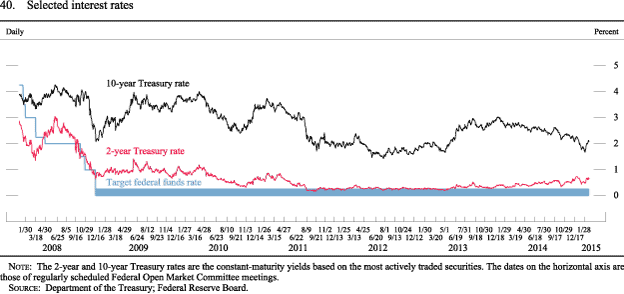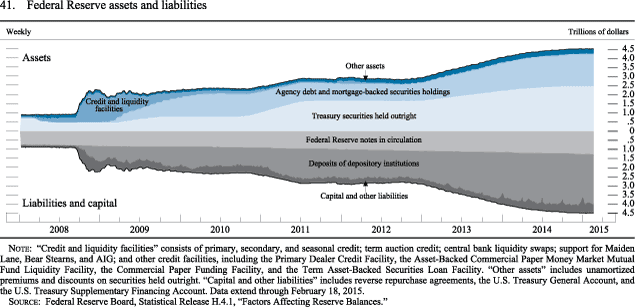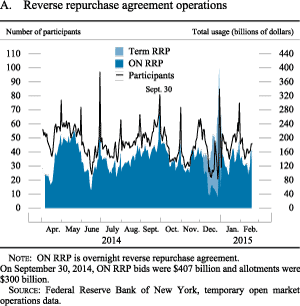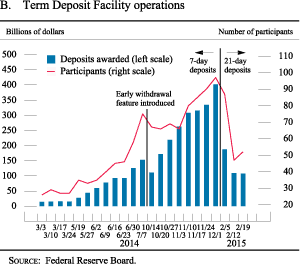- February 24, 2015: Summary
- Part 1
- Part 2
- Part 3
- Abbreviations
- Printable Version (1.21 MB PDF)

Part 2: Monetary Policy
Monetary Policy Report submitted to the Congress on February 24, 2015, pursuant to section 2B of the Federal Reserve Act
The Federal Open Market Committee (FOMC) concluded its asset purchase program at the end of October in light of the substantial improvement in the outlook for the labor market since the inception of the program. To support further progress toward maximum employment and price stability, the FOMC has kept the target federal funds rate at its effective lower bound and maintained the Federal Reserve's holdings of longer-term securities at sizable levels. To give greater clarity to the public about its policy outlook, the Committee has also continued to provide qualitative guidance regarding the future path of the federal funds rate. In particular, the Committee indicated at its two most recent meetings that it can be patient in beginning to normalize the stance of monetary policy and continued to emphasize the data-dependent nature of its policy stance. Following its September meeting, and as part of prudent planning, the Committee announced updated principles and plans for the eventual normalization of monetary policy.
The FOMC concluded its asset purchases at the end of October in light of substantial improvement in the outlook for the labor market
At the end of October, the FOMC ended the asset purchase program that began in September 2012 after having made further measured reductions in the pace of its asset purchases at the prior meetings in July and September.4 The decision to end the purchase program reflected the substantial improvement in the outlook for the labor market since the program's inception--which had been the goal of the asset purchases--and the Committee's judgment that the overall recovery was sufficiently strong to support ongoing progress toward the Committee's policy objectives. However, the Committee judged that a high degree of policy accommodation still remained appropriate and maintained its existing policy of reinvesting principal payments from its holdings of agency debt and agency mortgage-backed securities (MBS) in agency MBS and of rolling over maturing Treasury securities at auction. By keeping the Federal Reserve's holdings of longer-term securities at sizable levels, this policy is expected to help maintain accommodative financial conditions by putting downward pressure on longer-term interest rates and supporting mortgage markets. In turn, those effects are expected to contribute to progress toward both the maximum employment and price stability objectives of the FOMC.
To support further progress toward its objectives, the Committee has kept the target federal funds rate at its lower bound and updated its forward rate guidance
The Committee has maintained the exceptionally low target range of 0 to 1/4 percent for the federal funds rate to support further progress toward its objectives of maximum employment and price stability (figure 40). In addition, the FOMC has provided guidance about the likely future path of the federal funds rate in an effort to give greater clarity to the public about its policy outlook. In particular, the Committee has reiterated that, in determining how long to maintain this target range, it will assess realized and expected progress toward its objectives. This assessment will continue to take into account a wide range of information, including measures of labor market conditions, indicators of inflation pressures and inflation expectations, and readings on financial and international developments. Based on its assessment of these factors, before updating its guidance in December, the Committee had been indicating that it likely would be appropriate to maintain the current target range for the federal funds rate for a considerable time following the end of the asset purchase program, especially if projected inflation continued to run below the Committee's 2 percent longer-run goal and provided that longer-term inflation expectations remained well anchored.
In light of the conclusion of the asset purchase program at the end of October and the further progress that the economy had made toward the Committee's objectives, the FOMC updated its forward guidance at its December meeting. In particular, the Committee stated that it can be patient in beginning to normalize the stance of monetary policy, but it also emphasized that the Committee saw the revised language as consistent with the guidance in its previous statement.5 The Committee restated the updated forward guidance following its January meeting based on its assessment of the economic information available at that time.6
In her December press conference, Chair Yellen emphasized that the update to the forward guidance did not signify a change in the Committee's policy intentions, but rather was a better reflection of the Committee's focus on the economic conditions that would make an increase in the federal funds rate appropriate.7 Chair Yellen additionally indicated that, consistent with the new language, the Committee was unlikely to begin the normalization process for at least the following two meetings. There are a range of views within the Committee regarding the appropriate timing of the first increase in the federal funds rate, in part reflecting differences in participants' expectations for how the economy would evolve. By the time of liftoff, the Committee expects some further decline in the unemployment rate and additional improvement in labor market conditions. In addition, the Committee anticipates that, on the basis of incoming data, it will be reasonably confident that inflation will move back over the medium term to its 2 percent objective.
The Committee has reiterated that, when it decides to begin to remove policy accommodation, it will take a balanced approach consistent with its longer-run goals of maximum employment and inflation of 2 percent. In addition, the Committee continues to anticipate that, even after employment and inflation are near mandate-consistent levels, economic conditions may, for some time, warrant keeping the target federal funds rate below levels the Committee views as normal in the longer run. As emphasized by Chair Yellen in her recent press conferences, FOMC participants provide a number of explanations for this view, with many citing the residual effects of the financial crisis. These effects are expected to ease gradually, but they are seen as likely to continue to constrain household spending for some time.
The FOMC has stressed the data-dependent nature of its policy stance and indicated that if incoming information signals faster progress than the Committee expects, increases in the target range for the federal funds rate will likely occur sooner than the Committee anticipates. The FOMC also stated that in the case of slower-than-expected progress, increases in the target range will likely occur later than anticipated.
The size of the Federal Reserve's balance sheet stabilized with the conclusion of the asset purchase program
After the conclusion of the large-scale asset purchase program at the end of October, the Federal Reserve's total assets stabilized at around $4.5 trillion (figure 41). As a result of the asset purchases over the second half of 2014, before the completion of the program, holdings of U.S. Treasury securities in the System Open Market Account (SOMA) increased $56 billion to $2.5 trillion, and holdings of agency debt and agency MBS increased $78 billion to $1.8 trillion on net. On the liability side of the balance sheet, the increase in the Federal Reserve's assets was largely matched by increases in currency in circulation and reverse repurchase agreements.
Given the Federal Reserve's large securities holdings, interest income on the SOMA portfolio continued to support substantial remittances to the U.S. Treasury Department. Preliminary estimates suggest that the Federal Reserve provided more than $98 billion of such distributions to the Treasury in 2014 and about $500 billion on a cumulative basis since 2008.8
The FOMC continued to plan for the eventual normalization of monetary policy...
FOMC meeting participants have had ongoing discussions of issues associated with the eventual normalization of the stance and conduct of monetary policy as part of prudent planning.9 The discussions involved various tools that could be used to control the level of short-term interest rates, even while the balance sheet of the Federal Reserve remains very large, as well as approaches to normalizing the size and composition of the Federal Reserve's balance sheet.
To inform the public about its approach to normalization and to convey the Committee's confidence in its plans, the FOMC issued a statement regarding its intentions for the eventual normalization of policy following its September meeting. (That statement is reproduced in the box "Policy Normalization Principles and Plans.") As was the case before the crisis, the Committee intends to adjust the stance of monetary policy during normalization primarily through actions that influence the level of the federal funds rate and other short-term interest rates. Regarding the balance sheet, the Committee intends to reduce securities holdings in a gradual and predictable manner primarily by ceasing to reinvest repayments of principal on securities held in the SOMA. The Committee noted that economic and financial conditions could change, and that it was prepared to make adjustments to its normalization plans if warranted.
Policy Normalization Principles and Plans
During its recent meetings, the Federal Open Market Committee (FOMC) discussed ways to normalize the stance of monetary policy and the Federal Reserve's securities holdings. The discussions were part of prudent planning and do not imply that normalization will necessarily begin soon. The Committee continues to judge that many of the normalization principles that it adopted in June 2011 remain applicable. However, in light of the changes in the System Open Market Account (SOMA) portfolio since 2011 and enhancements in the tools the Committee will have available to implement policy during normalization, the Committee has concluded that some aspects of the eventual normalization process will likely differ from those specified earlier. The Committee also has agreed that it is appropriate at this time to provide additional information regarding its normalization plans. All FOMC participants but one agreed on the following key elements of the approach they intend to implement when it becomes appropriate to begin normalizing the stance of monetary policy:
-
The Committee will determine the timing and pace of policy normalization--meaning steps to raise the federal funds rate and other short-term interest rates to more normal levels and to reduce the Federal Reserve's securities holdings--so as to promote its statutory mandate of maximum employment and price stability.
- When economic conditions and the economic outlook warrant a less accommodative monetary policy, the Committee will raise its target range for the federal funds rate.
- During normalization, the Federal Reserve intends to move the federal funds rate into the target range set by the FOMC primarily by adjusting the interest rate it pays on excess reserve balances.
- During normalization, the Federal Reserve intends to use an overnight reverse repurchase agreement facility and other supplementary tools as needed to help control the federal funds rate. The Committee will use an overnight reverse repurchase agreement facility only to the extent necessary and will phase it out when it is no longer needed to help control the federal funds rate.
-
The Committee intends to reduce the Federal Reserve's securities holdings in a gradual and predictable manner primarily by ceasing to reinvest repayments of principal on securities held in the SOMA.
- The Committee expects to cease or commence phasing out reinvestments after it begins increasing the target range for the federal funds rate; the timing will depend on how economic and financial conditions and the economic outlook evolve.
- The Committee currently does not anticipate selling agency mortgage-backed securities as part of the normalization process, although limited sales might be warranted in the longer run to reduce or eliminate residual holdings. The timing and pace of any sales would be communicated to the public in advance.
- The Committee intends that the Federal Reserve will, in the longer run, hold no more securities than necessary to implement monetary policy efficiently and effectively, and that it will hold primarily Treasury securities, thereby minimizing the effect of Federal Reserve holdings on the allocation of credit across sectors of the economy.
- The Committee is prepared to adjust the details of its approach to policy normalization in light of economic and financial developments.
Footnotes
Note: See Board of Governors of the Federal Reserve System (2014), "Federal Reserve Issues FOMC Statement on Policy Normalization Principles and Plans," press release, September 17, www.federalreserve.gov/newsevents/press/monetary/20140917c.htm.
...including by testing the policy tools to be used
The Federal Reserve has continued to test the operational readiness of its policy tools, conducting daily overnight reverse repurchase agreement (ON RRP) operations, a series of term RRP operations, and several tests of the Term Deposit Facility. To date, testing has progressed smoothly, and short-term market rates have generally traded above the ON RRP rate, which suggests that the facility will be a useful supplementary tool for the FOMC to use in addition to the interest rate it pays on excess reserves (the IOER rate) to control the federal funds rate during the normalization process. Overall, testing operations reinforced the Federal Reserve's confidence in its view that it has the tools necessary to tighten policy at the appropriate time. (For more discussion of the Federal Reserve's preparations for the eventual normalization of monetary policy, see the box "Additional Testing of Monetary Policy Tools.")
Additional Testing of Monetary Policy Tools
The size of the Federal Reserve's balance sheet stands at about $4.5 trillion, and reserve balances in the banking system are close to $2.5 trillion, an extraordinarily elevated level relative to the average level of reserve balances prior to the onset of the financial crisis--about $25 billion. As a result, when the Federal Open Market Committee (FOMC) eventually chooses to begin removing policy accommodation, it will do so with a level of reserves in the banking system far in excess of that during any prior period of policy tightening. As noted in the previous Monetary Policy Report, the Federal Reserve's elevated balance sheet implies that the traditional mechanism for tightening policy will not be feasible.1
As discussed in its Policy Normalization Principles and Plans, the Federal Reserve intends to move the federal funds rate into the target range set by the FOMC primarily by adjusting the interest rate it pays on excess reserve balances (the IOER rate). During policy normalization, the Federal Reserve also intends to use an overnight reverse repurchase agreement (ON RRP) facility and other supplementary tools--including term reverse repurchase agreements (term RRPs) and term deposits offered through the Term Deposit Facility (TDF)--as needed to help control the federal funds rate. As part of prudent planning, the Federal Reserve continued to test the operational readiness of these tools over the past several months, with testing evolving in terms of the offering formats, tenors and rates offered, maximum awards or allotment amounts, and eligible counterparties.2
With respect to RRP operations, the Federal Reserve has continued to conduct daily overnight operations and began to conduct term operations. The testing of different formats for the ON RRP operations aimed to enhance the FOMC's understanding of how an ON RRP facility might be structured to best balance the objective of supporting monetary control with those of limiting the Federal Reserve's role in financial intermediation and mitigating potential financial stability risks the facility might pose during periods of stress.3 In addition, the spread between the ON RRP rate and the IOER rate was varied to provide the FOMC with information about the effect of that spread on money markets and the demand for ON RRPs.
With these considerations in mind, at its September meeting, the FOMC approved changes in the ON RRP exercise that included raising the counterparty-specific limit from $10 billion to $30 billion, limiting the overall size of each operation to $300 billion, and introducing an auction process that would be used to determine the interest rate and allocate take-up if the sum of bids exceeded the overall limit. In addition, during the fourth quarter of 2014, the FOMC approved further changes in the exercise under which the offering rate at the ON RRP operations was varied between 3 and 10 basis points. Participation in and usage of ON RRPs fluctuated from day to day, reflecting changes in the spread between market rates and the ON RRP rate as well as quarter-end and year-end dynamics figure A). The limit on the overall size of the operation did not bind except at the end of the third quarter.4 Increases in ON RRP offered rates appeared to put some upward pressure on unsecured money market rates, as anticipated, and the offered rate continued to provide a soft floor for secured rates. Changes in the ON RRP offered rate induced changes in the spread between the IOER rate of 25 basis points and the ON RRP offered rate for those days. Those changes did not appear to affect the volume of activity in the federal funds market.
The term RRP operations approved for the end of 2014 were aimed at providing the FOMC with information about the potential effectiveness of this supplementary policy tool in helping to control the federal funds rate, particularly when there are significant and transitory shifts in money market activity, such as over quarter- and year-ends. To this end, the Federal Reserve conducted term RRP operations on December 8, 15, 22, and 29, with offering amounts of $50 billion for each of the first two operations and $100 billion for each of the latter two operations.5 Although the first two term auctions were oversubscribed, the third and fourth term operations were undersubscribed. Overall, the ON RRP and term RRP operations appeared to ease downside rate pressures in money markets over year-end, and the unwinding of all four term operations on January 5, 2015, was orderly. The Federal Reserve will conduct a further test of term RRPs over quarter-ends with a series of term RRP operations spanning the March 2015 quarter-end. Also, to help advance its understanding of how term RRPs could help to control the federal funds rate, the Federal Reserve has begun a series of four term RRP test operations that do not span a quarter-end date. The first two of these operations were conducted on February 12 and on February 19. Both operations were oversubscribed, and the awarded interest rate on these two term RRPs was in line with the awarded rate on concurrent ON RRP operations.
The Federal Reserve's testing of the TDF also continued to evolve in the second half of 2014 and early 2015, with the aim of increasing participation by depository institutions as well as improving operational readiness. Since the previous Monetary Policy Report, the Federal Reserve conducted two series of TDF test operations. In the second half of 2014, a series of eight TDF test operations included an early withdrawal feature that allowed depository institutions to withdraw funds held in term deposits on payment of an early withdrawal penalty.6 The maximum award amount per institution and the interest rate paid on term deposits offered through the facility were raised gradually over the course of the series in a manner broadly similar to the series of test operations conducted earlier in the year that did not include an early withdrawal feature. The level of activity increased considerably relative to the earlier test operations, with take-up reaching just over $400 billion at the final operation and nearly 100 depository institutions participating (figure B). In the second series of test operations, held in February 2015, the Federal Reserve conducted a series of weekly TDF operations offering 21day term deposits that settled on the same day the operation was executed, eliminating the 3day lag between the execution of an operation and settlement in previous tests. On net, the series results provide additional evidence that significant take-up can occur at a few basis points over the IOER rate even for longer terms.
Footnotes
1. For further discussion of how the alternative policy tools affect a range of short-term interest rates, see the box "Planning for Monetary Policy Implementation during Normalization" in Board of Governors of the Federal Reserve System (2014), Monetary Policy Report (Washington: Board of Governors, July), www.federalreserve.gov/monetarypolicy/mpr_20140715_part2.htm. Return to text
2. The types of counterparties that are currently eligible to participate in the Federal Reserve's ON RRP operations include depository institutions, money market funds, government-sponsored enterprises, and primary dealers, while only depository institutions may participate in TDF operations. At its December 2014 meeting, the FOMC reauthorized the ON RRP test operations through January 29, 2016. On January 16, 2015, the Federal Reserve Bank of New York announced the addition of 25 RRP counterparties, bringing the total number of counterparties to 164. These newly added counterparties are currently in the process of finalizing the operational details. Results of RRP operations can be found on the Federal Reserve Bank of New York's website at www.newyorkfed.org/markets/omo/dmm/temp.cfm ![]() , and results of the TDF operations can be found on the Federal Reserve Board at www.federalreserve.gov/monetarypolicy/tdf.htm. Return to text
, and results of the TDF operations can be found on the Federal Reserve Board at www.federalreserve.gov/monetarypolicy/tdf.htm. Return to text
3. For a discussion of issues related to the use of ON RRPs as a supplementary tool during normalization, see Josh Frost, Lorie Logan, Antoine Martin, Patrick McCabe, Fabio Natalucci, and Julie Remache (2015), "Overnight RRP Operations as a Monetary Policy Tool: Some Design Considerations," Finance and Economics Discussion Series 2015-010 (Washington: Board of Governors of the Federal Reserve System, February), www.federalreserve.gov/econresdata/feds/2015/files/2015010pap.pdf. Return to text
4. As term RRP operations crossing year-end were conducted in addition to ON RRP operations, the limit on the overall size of the ON RRP operations did not bind at year-end. Return to text
5. For details on the format of these operations, see the December 1, 2014, Statement Regarding Term Reverse Repurchase Agreements on the Federal Reserve Bank of New York's website at www.newyorkfed.org/markets/opolicy/operating_policy_141201.html ![]() . Return to text
. Return to text
6. The early withdrawal option makes such deposits eligible to meet requirements under the Basel III Liquidity Coverage Ratio. Return to text
Footnotes
4. See Board of Governors of the Federal Reserve System (2014), "Federal Reserve Issues FOMC Statement," press release, October 29, www.federalreserve.gov/newsevents/press/monetary/20141029a.htm. Return to text
5. See Board of Governors of the Federal Reserve System (2014), "Federal Reserve Issues FOMC Statement," press release, December 17, www.federalreserve.gov/newsevents/press/monetary/20141217a.htm. Return to text
6. See Board of Governors of the Federal Reserve System (2015), "Federal Reserve Issues FOMC Statement," press release, January 28, www.federalreserve.gov/newsevents/press/monetary/20150128a.htm. Return to text
7. See Board of Governors of the Federal Reserve System (2014), "Transcript of Chair Yellen's FOMC Press Conference," December 17, www.federalreserve.gov/mediacenter/files/FOMCpresconf20141217.pdf. Return to text
8. See Board of Governors of the Federal Reserve System (2015), "Reserve Bank Income and Expense Data and Transfers to the Treasury for 2014," press release, January 9, www.federalreserve.gov/newsevents/press/other/20150109a.htm. Return to text
9. See Board of Governors of the Federal Reserve System (2014), "Minutes of the Federal Open Market Committee, July 29-30, 2014," press release, August 20, www.federalreserve.gov/newsevents/press/monetary/20140820a.htm. Return to text




